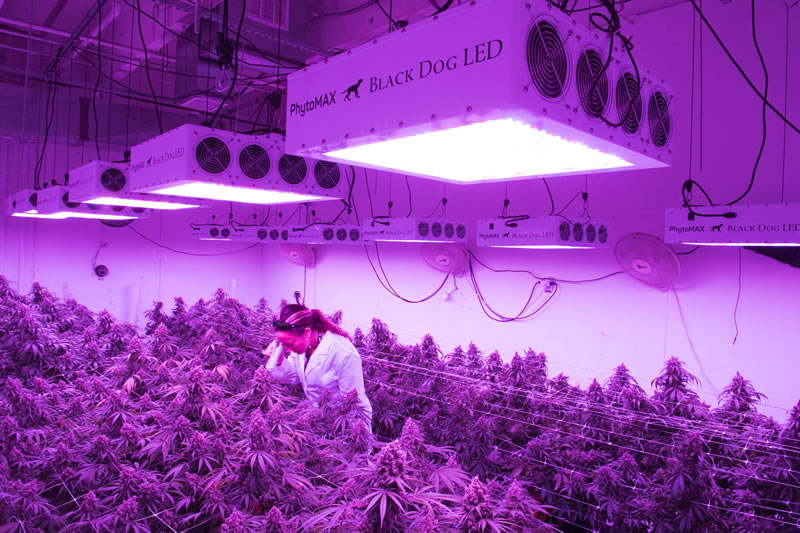 Growers who want to be successful know that they need to use the best LED grow lights for their grow operation. LED grow lights consume less energy, provide larger coverage, and produce a broader spectrum of light. This means a lower electric bill, fewer hotspots, better photosynthesis, and better harvests.
Growers who want to be successful know that they need to use the best LED grow lights for their grow operation. LED grow lights consume less energy, provide larger coverage, and produce a broader spectrum of light. This means a lower electric bill, fewer hotspots, better photosynthesis, and better harvests.
CFL’s are popular for seedlings and veg, but today their light spectrum is too weak compared to LEDs. For years, growers swore by HID (High-Intensity Discharge) lights because they provided great lighting with great results.
However, HID’s have kept many growers from even getting started due to their initial cost and the complexity of their setup.
LED grow lights have proven to be more cost-effective, eco-friendly, and efficient at improving photosynthesis. Grow lights are also useful in helping to create healthier plants that grow better buds.
Don’t simply opt for cheap LED grow lights. Shopping for the right indoor grow lights may seem overwhelming at first, but with this guide, you’ll be able to compare and make an informed buying decision.
Full Contents
- 1 What Are LED Grow Lights?
- 1.1 The Top 10 Best LED Grow Lights of 2023
- 1.2 1. MarsHydro Reflector 96 – The Best Grow Light for Growing Marijuana
- 1.3 2. Black Dog LED PhytoMax-2 200 – Second Best Rated LED Light
- 1.4 3. Lush Lighting Lumenator 2x – Another Solid LED Plant Light
- 1.5 4. Advanced LED Lights Diamond Series XML 350 – A Top Rated Light for Indoor Marijuana Growing
- 1.6 5. California Lightworks Solar System 550 – Far from a Cheap LED Grow Light
- 1.7 6. Kind LED K5 XL 750 – Boasts an Extra Large Footprint
- 1.8 7. MarsHydro Pro II Cree 256 – A Very Powerful & Flexible Option
- 1.9 8. Horticultural Lighting Group HLG 550 – Best for Grow Tents
- 1.10 9. Johnson Grow Lights LED CX-16 – Even Light Spread & Low Heat
- 1.11 10. NextLight Mega LED Grow Light – Most Efficient & Best Commercial Option
- 2 Everything to Know Before Buying LED Grow Lights
- 2.1 How To Choose the Right Grow Light For the Area You Need to Cover
- 2.2 LED Grow Lights FAQ’s
- 2.2.1 What are the benefits of LED grow lights?
- 2.2.2 How far should LED grow lights be from plants?
- 2.2.3 How many LED watts will you need per sq ft of your grow space?
- 2.2.4 Can I use HID lights for veg and switch to LEDs for flower later on?
- 2.2.5 Does my LED grow light produce UV radiation?
- 2.2.6 Does LED grow light give off heat?
- 2.2.7 What’s the best light color to grow marijuana plants in?
- 3 The Bottom Line
What Are LED Grow Lights?
LED grow lights are made up of several light-emitting diodes, normally inside a casing with a heat sink and several fans that are built-in. LED grow lights can be plugged right into a wall’s socket.
Depending on your grow operation, you may need different color LED lights. For example, red, far-red, green or blue lights can influence the plant’s growth and flowering. After various studies, it was found that most plants will grow safely if given blue and red lights. And, while blue and red lights are relatively cheap, your plants will experience better growth with green lights. Additionally, depending on the strain type – sativa or indica dominant, like pink kush for example, can factor into what type of LED lights to buy.
White LED grow lights emit a full spectrum of light. Such lights are the closest thing to natural lights, giving off a balanced spectrum of green, blue, and red to your weed plants. To prevent your leaves from burning, lower wattage LED grow lights should be placed about 12 inches away from plants (300-watt lights). If you plan on using stronger, 1000-watt or higher type of grow lights, place these light at least 36 inches away from your grow.
Years ago, LED lighting was not an affordable option. Costs have greatly diminished now, as more LED light manufacturers and brands are coming into the market. LED grow lights are still more expensive than any other type of LED lighting, mainly because they are designed to be more energy-efficient.
LED grow lights often come with fans to cool them down, as their power and high-wattage draw lots of energy. When you keep lights at a low temperature, they’re more likely to omit more brightness and last longer. LED lights often last between 50,000-90,000 hours.
The Top 10 Best LED Grow Lights of 2023
| Product Image | |||
|---|---|---|---|
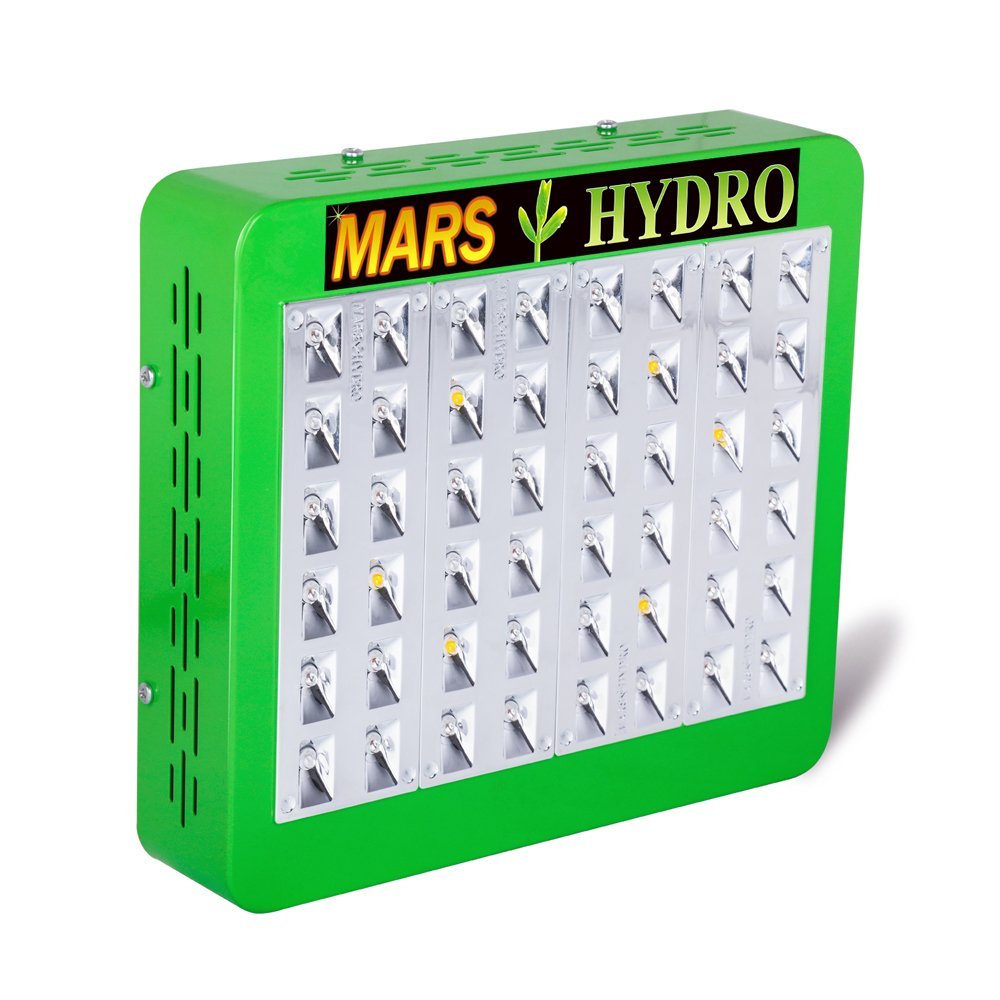 | MarsHydro Reflector 96 | ||
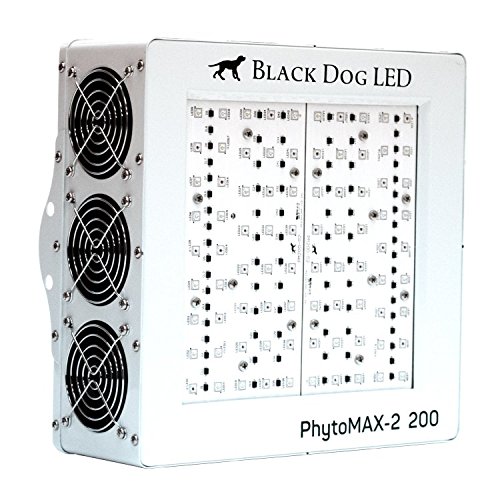 | Black Dog LED PhytoMax-2 200 | ||
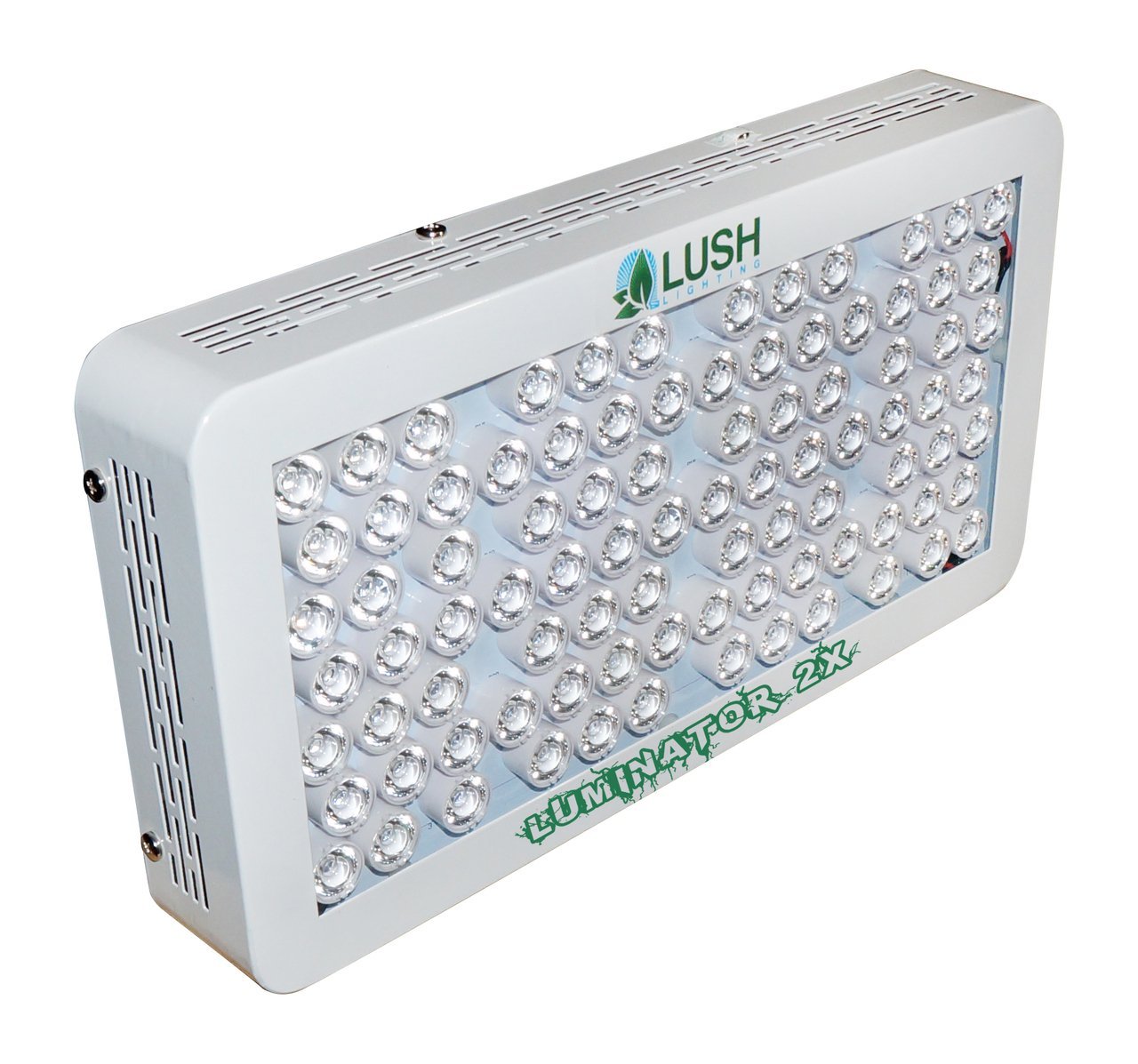 | Lush Lighting Lumenator 2x | ||
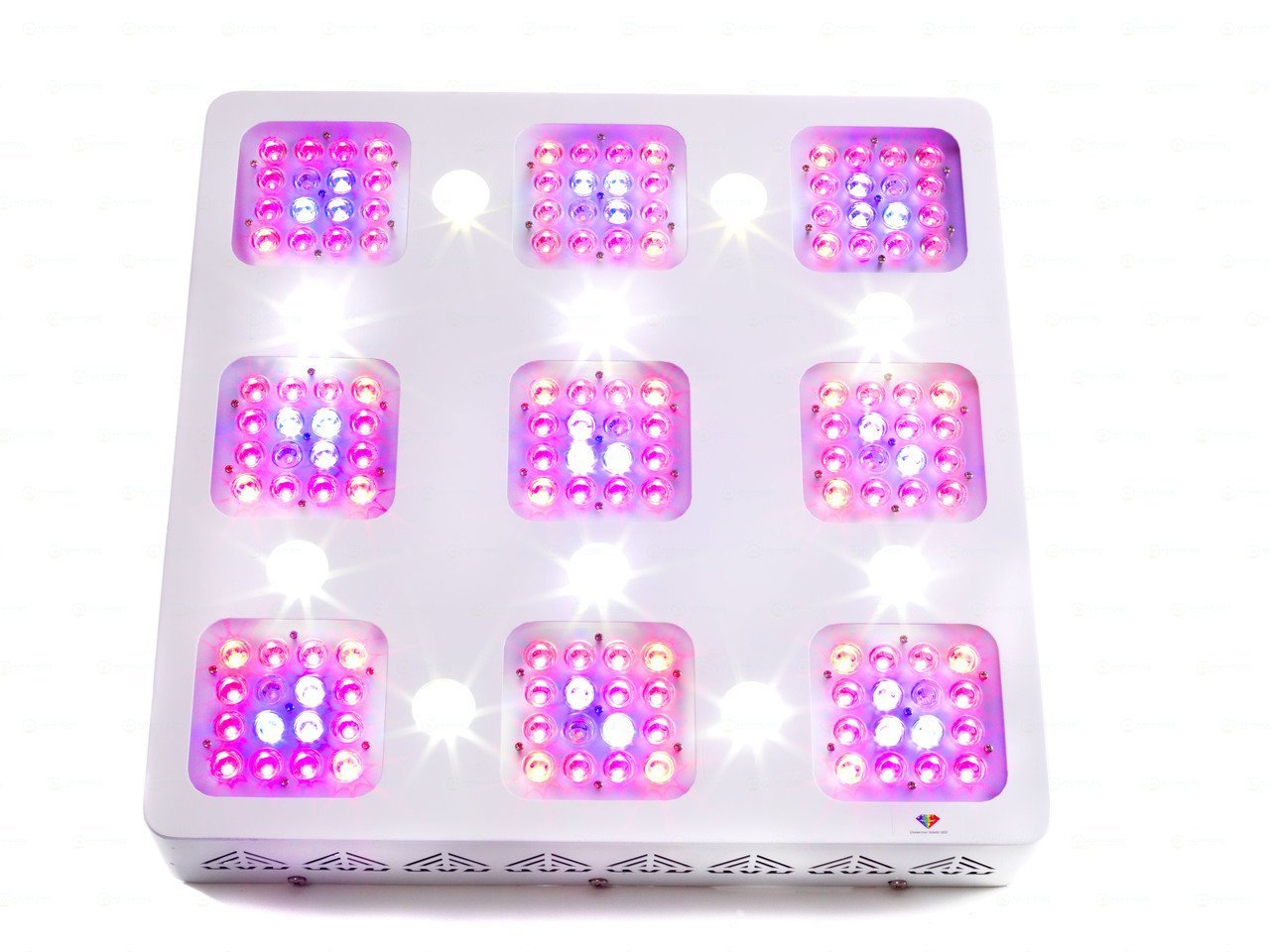 | Advanced LED Lights Diamond Series XML 350 | ||
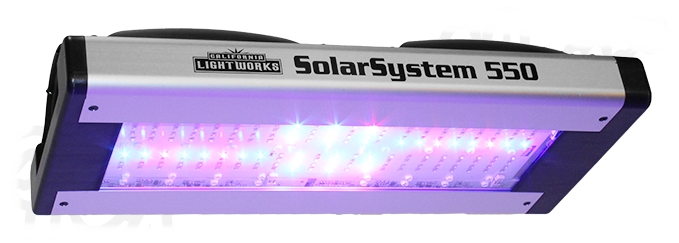 | California Lightworks SolarSystem 550 | ||
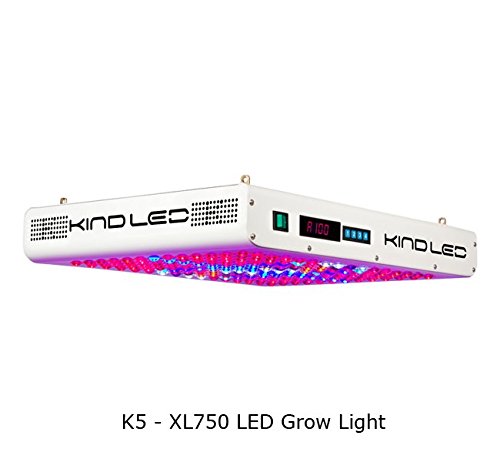 | Kind LED K5 XL750 | ||
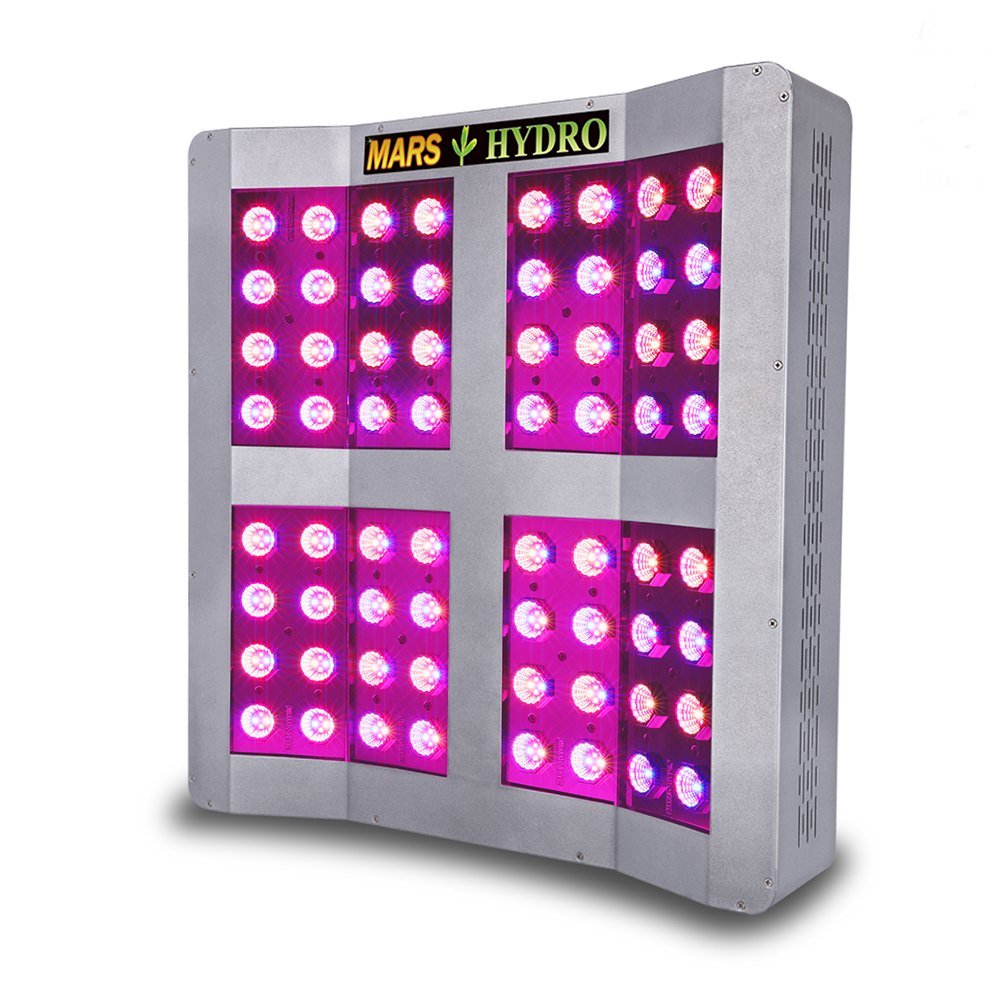 | MarsHydro Pro II Cree 256 | ||
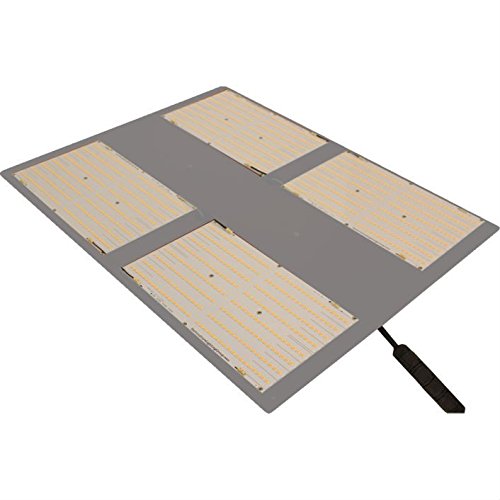 | Horticultural Lighting Group HLG 550 | ||
 | Johnson Grow Lights LED CX-16 | ||
 | NextLight Mega LED Grow Light |
We ranked the top LED grow lights based on their maximum coverage area, HID equivalence, and average wattage draw. These are the basic factors, but along with your budget, the intensity and efficiency of marijuana grow light is very important. This is, of course, relative to your grow space.
Take a look at our video below, where we break down the features of each grow light and its benefits.
1. MarsHydro Reflector 96 – The Best Grow Light for Growing Marijuana
 A full spectrum LED light producing white light between 430nm and 670nm, as well as far-red light at 730nm, the Reflector 480 from MarsHydro is our top choice among the best LED grow lights for sale.
A full spectrum LED light producing white light between 430nm and 670nm, as well as far-red light at 730nm, the Reflector 480 from MarsHydro is our top choice among the best LED grow lights for sale.
It’s loaded with 96 5-Watt Epistar LED’s that produce 480 Watts of light output, while only drawing an average of 190 Watts. When 18” above the canopy, its average PAR is 680 µmol./m2/s.
It weighs in at 10 lbs, and thanks to its pincushion heat sinks, it has a heat output of only 467 BTU. Its life rating is 50k-100k hours and comes with a 2-year warranty, serviced in California.
This light is ideal for growers on a budget who need plenty of light intensity. Its maximum coverage is nearly 22 square feet (2.5’ x 3.5’). With the Reflector 96, you could easily veg 9-11 plants, depending on square footage of space for each plant.
Further Review of the MarsHydro Reflector 96
You could flower 3-4 plants or even more if you were using a grow tent. With two of these lights, you can get some serious growth happening.
The box comes with just about everything you could ever need with regard to grow lights. There are not any instructions. However, most growers will not mind because it is a self-explanatory lighting system that’s fairly easy to set up and use. Simply plug in your power cord, fasten the hangers securely, and insert the plug into the outlet.
The heat emitted by this system is minimal, especially on the veg setting. Nonetheless, this light is equipped with a fan that keeps it even cooler while not using a lot of electricity. So, if you are looking for an energy efficient solution for continuous usage that doesn’t give off a lot of heat, MarsHydro Reflector 96 is a good choice.
Features:
- LED grow lights full Spectrum, 5 bands, including white light and far-red light
- Compact reflector design supports high light output
- Epistar LED
- Veg/Bloom switches allow you to grow from start to finish in one place
- ETL certificated
- Plug with VDE and UL certification wires
- Purchase includes LED grow light, power cord, and hanging kit.
2. Black Dog LED PhytoMax-2 200 – Second Best Rated LED Light
With these powerful LED grow lights for weed, you get a broad energy spectrum and high light intensity without hot spots. That way it offers great coverage to nourish flowers and lower leaves.
Best of all, it has minimal electrical requirements so that your bills won’t show noticeable changes. It’s a great way to save money and achieve incredible grow results.
Hosting 84 high-output, top-bin, 5-watt LED’s from manufacturers like Cree and Osram, this LED light puts out 420 watts while only drawing 210 watts. The Black Dog can replace any 400-watt HID or HPS and has a dedicated full spectrum of light.
This range from ultra-violet light to near-infrared (365-750nm), targeting photosynthetic peaks and efficiency. The light weighs 14 lbs and puts off 716 BTU. It has a life expectancy of 70k hours and a 5-year warranty.
Its maximum coverage for flowering is 9 square feet (3’ x 3’), at 21” above the canopy produces an average PPFD of 330 µmol./m2. That’s kind of low, but for smaller home grows with a smaller area, the Black Dog can produce up to 971 µmol./m2/s when just over 1 foot above the canopy.
Best Suited For
This LED panel is suited to smaller grows where it is of the utmost importance to save space and energy without compromising light intensity or quality.
Another awesome full spectrum, full-cycle light, the PhytoMax-2 200 is best for smaller growing operations. It is ideal if you grow from start to harvest in one place and require quality equipment.
That’s an enormous amount of usable Photosynthetic Active Radiation (PAR) coming from a 420-watt light fixture.
Features:
- 84 high end 5-watt LED’s from industry leaders like CREE and Osram
- Durable, easy to clean glass lenses.
- Patented Phyto-Genesis Spectrum (UV-NIR)
- ETL certified to UL safety standards
- 70,000 hour lifespans on fans
- 8 foot light hangers
- 5 year warranty
3. Lush Lighting Lumenator 2x – Another Solid LED Plant Light
Why choose Luminator 2x? If you’re looking to run your own grow plot on a tight budget, you will want to use the low-cost LED grow lights that are engineered with the use of biochemical research. Other competing companies only do so superficially without carrying out deep research for their products.
The Lumenator also offers lots of advantages over HID lights, including the low operating costs, a great deal of power, massive versatility, relatively small size, adjustable design, just to name a few.
On top of that, this grow light system runs cold so you will not have a problem with overheating. No need for ballast given that it is designed as a straightforward Plug-N’-Plant unit.
Further Review of the Lush Lighting Lumenator
The Luminator’s light is a great buy for growers working in closets and tents. It’s putting out 270 LED watts, while only taking 190 from the wall.
That doesn’t sound like so much, but when you consider that, at its maximum coverage for flowering, 3’ x 3’ (9 ft. squared) at 2.5’ above the canopy, it can produce 500 µmol./m2/s of PAR light.
Also, when at 1.5’ squared and 1 foot above the canopy, it’s pumping out 1,500 µmol./m2/s of PAR light, you start to understand why the Luminator can replace any high-end 600-watt HPS grow light.
The full spectrum of this LED grow light ranges from UV-light to infrared light. While focusing its bands in the blues and reds, it’s still able to provide the subsequent greens and even IR wavelengths that plants need.
With this great light fixture, you can really control the light intensity needed specific to your grow without sacrificing quality or efficiency. There’s a lot of power is packed into this 7 lb. light fixture!
Features:
- 90 high intensity 3 watt LED’s
- Plug and play power operation
- Double lens optic direct light downward, doubling intensity
- Mounting hardware included
- Large, aluminum heat sync and tempered steel construction
- 90-day money back guarantee
- 3-year warranty
- 50,000-hour life expectancy
4. Advanced LED Lights Diamond Series XML 350 – A Top Rated Light for Indoor Marijuana Growing
 I would suggest taking a look at all of the Advanced LED Lights Diamond series, but for now, let’s examine the XML 350.
I would suggest taking a look at all of the Advanced LED Lights Diamond series, but for now, let’s examine the XML 350.
It’s sporting 10, 10W top bin CREE LED’s and 144, 3 W Bridgelux LEDs. They can produce a PAR light output equal to most 600w HPS lights on the market. 532 LED watts are shining down through 90 degree XML collimator lenses while only drawing 330 watts.
This is one of the best full spectrum LED grow lights on the market. It has more than at least a dozen wavelengths in its full spectrum (380nm-760nm) emission, which allows for full cycle plant growth, in one space.
Interestingly unique to the Diamond series is the dimming switch, which can be specified to a particular color of the light spectrum. It also enhances effectiveness during different growth cycles.
With a maximum coverage of 20.25 square feet (4.5’ x 4.5’), this light could easily flower 8-10 plants. This light is a bit heavy at 18 lbs, but comes equipped with a dual heat sink, and a honeycomb fan cover with a dust filter.
Best Suited For & Highlights
The Advanced LED Lights Diamond Series XML 350 is the perfect light for growers with a little more space than just the closet. It’s big, heavy, and expensive. But, remember that this type of light is also super powerful, efficient, and made with high-end parts.
What you will like about this light is that it runs cool and quiet, while saving you a lot of money in comparison with equivalent HID grow lights. Maybe it isn’t the cheapest light around, but it is surely one of the best 600W LED grow lights out there.
Yet we find it worth paying a bit extra considering that you get superior LED dimmer switches for all cannabis growth cycle stages, high-quality components, solid build quality, efficient cooling, and excellent warranty. All of this translates in excellent value for money.
It also has some really awesome additional features like daisy chaining, color select dimming, doubled lens optics, and even comes with a LED light grow guide.
Features:
- Top bin LED’s from CREE and Bridgelux
- 90 degree XML collimator lens optics
- Advanced LED drivers
- Color select dimmer switches for clone, veg, and flower modes
- Fan cover, dust filter, and diamond vents help to create very low heat output
- Daisy chain up to four lights with one cord
- Includes LED grow guide
- Six foot 110v power cord (international plugs available)
- 3-year warranty
5. California Lightworks Solar System 550 – Far from a Cheap LED Grow Light
Solar System 550 is perfect for large indoor grow operations. The manufacturer, California LightWorks, has installed high-efficiency LED’s from Osram and a highly advanced digital programming system.
It replaces any 600-watt HPS using 40% less energy. It has a wattage draw of 400 watts from the wall while producing a PPFD of 642 µmol./s at a maximum coverage area. The coverage area for plants in veg is up to 48 sqft, and it only weighs 13 lbs. Additionally, it’s 1.5’ long and only 8.5” wide, with a 4” depth.
The spectrum provided by this grow light ranges from below 400nm to beyond 700nm. It is completely programmable to achieve the best results during all phases of growth. This is where the Solar System 550 sets itself apart in the LED grow light market.
From a single controller programming, you can set custom timing and spectrum parameters of an entire commercial grow. It can do that because it has unlimited daisy-chaining capabilities. Imagine being able to customize grow schedules for particular strains, at your fingertips. What’s neat is that the controller is compatible with the entire Solar System series of LED lights.
Further Review of the California Lightworks Solar System
This light heats up a bit, producing 1280 BTU. for flowering, with enough intensity to produce a substantial harvest from at least six large plants. Whether it’s one light for home growing or a gigantic warehouse, this light is quite advanced compared to the rest on the market.
The package includes Method Seven Operator LED+ glasses, a couple of 1/8” fastening ratchet ropes, and the controller. The glasses are designed specifically to filter out radiation, which allows for more comfortable and safe operation.
The controller is particularly useful for growing in vast areas with various plants that demand unique operating conditions. With this single controller, you will be able to efficiently control a number of LED plant grow lights at once. There are also two ratchet ropes to hang the unit.
Overall, California 550 LED grow light is considered an effective investment that pays off in the long run. This user-friendly product boasts great performance and durability. With its easy and interactive controls, this light system can engage the amateurs, whereas experienced growers will surely like its versatility and networking abilities.
Features:
- Completely Programmable Full-Spectrum / Full-Cycle Control
- 50,000 Hour High Power Osram LED’s
- 50,000 Hour water resistant fans
- Sunrise and Sunset lighting
- Automatic voltage regulation
- Compact and Light Weight, But A Lot of Power
- Active Thermal Management
- 6 Foot Power Cord
- UL & CE certificated
- 5 Year Warranty
6. Kind LED K5 XL 750 – Boasts an Extra Large Footprint
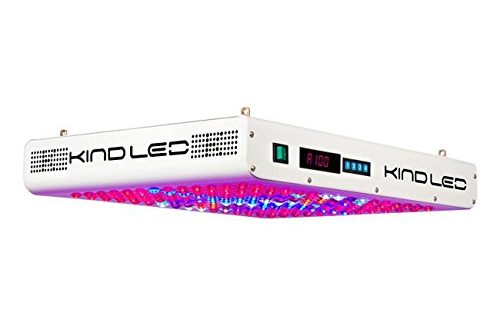 The beautiful, and humble, 28 lb. K5 XL 750 is a top of the line LED grow light. It is finally stepping up to meet HID and HPS average yield and efficiency spec comparisons. It has a maximum wattage draw of only 430W.
The beautiful, and humble, 28 lb. K5 XL 750 is a top of the line LED grow light. It is finally stepping up to meet HID and HPS average yield and efficiency spec comparisons. It has a maximum wattage draw of only 430W.
Kind claims it to be a true 750 W HID replacement. Also, they mentioned it is 40-50% more efficient than its HID counterparts.
Kind has created a unique balance of 208 5W and 3W LED diodes. This ensures powerful light output without any overheating or burning issues.
The diodes emit a 12 band spectrum that is designed to match the needs of the different growth cycles of plants. It can also be completely programmed and customized by a single remote control. With 16 sq ft coverage of 750 LED watts, you can grow 8 to 10 massive plants in one place, without having to ever change lighting systems or move plants.
One of the most innovative and coolest features we have seen is its ability to completely customize the light spectrum emitted by the panel. That makes it favorable for any growth phase, be it cloning, seedling, vegging, or flowering.
Another useful feature most growers will appreciate is a built-in timer that automatically turns on/off the lights as per your preference. All you need to do is set up a schedule according to your needs.
Features:
- Pulse Width Modulation Dimming
- Extra Large Footprint
- Fully Customizable Spectrum
- UL listed
- 1 Controller Digitally Programs All Light Cycles and Timers
- 8 Stage “Mother Earth” timing function
7. MarsHydro Pro II Cree 256 – A Very Powerful & Flexible Option
 The Pro II is the economic version of the prior MarsHydro Pro Cree 256. It hosts 256 top bin diodes from Cree and can replace an 800W HPS or HID. It provides the full spectrum of light and a controllable switch for veg and flowering cycles.
The Pro II is the economic version of the prior MarsHydro Pro Cree 256. It hosts 256 top bin diodes from Cree and can replace an 800W HPS or HID. It provides the full spectrum of light and a controllable switch for veg and flowering cycles.
Its maximum coverage is 4’ x 4’ (16 sq. ft.). From 1.5’ above the canopy, it’s providing enough light output to flower 8 to 16 mega plants.
It is a bit heavier, at 36 lbs. Its 800 watts has a heat factor of 1883 BTU, drawing at full power up to 680W. It’s got a beautiful, nearly square design, resulting in an even footprint, and it’s LED’s have a 100,000-hour lifespan.
This is the perfect light for the home grower dealing expecting big yields but needs to stay within budget. It is meant to be an easy to use and efficient LED light system that is tailored for homegrown plants.
As a matter of fact, this series is aimed at cannabis growers in particular. They can use these LED lights throughout the life cycle of marijuana plants, from growing to flowering.
With this high-tech unit, you will not have to tweak other settings or adjust the temperature. Believe it or not, it takes care of just about everything on its own!
Features:
- High-Intensity Cree LED’s
- Full Spectrum with Spectra Technology provides full coverage at 100% efficiency and power
- 100 degree Lens Angle
- Cup Reflector Secondary Optics
- Aircraft-Grade Aluminum Heat Sinks
- Dual Ball Bearing Cooling Fans
- Switch Control for Veg and Bloom Cycles
- International Plugs for Global Plug and Play
- Comes With Power Cord and Hangers
- 30 day return and 2-year warranty
8. Horticultural Lighting Group HLG 550 – Best for Grow Tents
 When you need to do some serious growing, turn to the HLG 550. The Horticulture Lighting Group has defined the top of the line for LED grow lights. At its maximum coverage of 20 sq ft, it shines down a PPFD of 1,265 µmol./m2/s. Also, it only draws a maximum of 515 watts.
When you need to do some serious growing, turn to the HLG 550. The Horticulture Lighting Group has defined the top of the line for LED grow lights. At its maximum coverage of 20 sq ft, it shines down a PPFD of 1,265 µmol./m2/s. Also, it only draws a maximum of 515 watts.
That level of intensity will easily replace any high-end 1000W HID or HPS.
It utilizes four independent “quantum boards”, equipped with a total of 1,152 Top Bin Samsung LM561C S6 LED’s. It emits a 3000k full spectrum that is packed with the essential wavelengths needs for optimal growth.
This light has a PAR efficiency of 2.4µmol./m2/J. That means it’s super efficient on energy. It will evenly cover up to 36 sq. ft. of plants in veg. This light is ideal for large scale grow operations, but can be easily scaled to use for serious home growers.
Best Suited For & Highlights
Some of the most attractive advantages include high-quality parts used, passively cooled fixture design that eliminates the need for fans, the optimal spread of light, and good coverage area. When it comes to the drawbacks, it is important to note that there’s no cover for the led boards while the quantum boards are quite fragile.
The HLG 550 is great for beginners and it comes in handy when you want to transition from growing with bulbs. You can use it for either veg or bloom stage, as it easily goes from seed to bud thanks to the full spectrum of light.
Incredibly powerful and efficient over massive square footage, the HLG 550 is simply awesome.
Features:
- High-Efficiency White Light Quantum Boards
- White Light Full Spectrum
- Passive Cooled Design
- Dimmable Power Supply
- 3 Year Warranty
- Ideal for Grow Tents, As Well As Large Spaces
9. Johnson Grow Lights LED CX-16 – Even Light Spread & Low Heat
Despite the fact that Johnson Grow Lights is a relative newcomer to the world of LED grow lights, they are known for producing some of the top-of-the-line products that provide ideal cannabis-growing conditions.
The CX-16 utilizes 16 powerful Citizen CLU048 diodes. It consumes 715 watts at peak while producing a peak PPF of 1,240 µmol. Also, a peak PPF density of 840 µmol./m2 over a 4’ x 4’ (16 sq. ft.) canopy.
That’s more than enough power to bring a big harvest of at least 8 plants. Compared to comparable HID lights, it is much more energy efficient.
This light fixture will replace any HID or HPS of 1000 watts. It provides a massive full spectrum of wavelengths needed for optimal growth. It hangs about 2.5’-3’ above the canopy and only produces 2450 BTU.
The CX-16 produces a full spectrum of light, similar to sunlight your plants use for growth and photosynthesis. A typical HID will be creating 3500-4000 BTU. This unit is 2’ by 2’ and 4.5” in depth, but incredibly has a maximum coverage area for veg of 49 sq. ft.
Best Suited For & Highlights
The LED CX-16 is for serious growers who want to get the job done right. It is perfect for large areas and grow tents, this is an incredibly powerful and well-built machine. Even though this fixture is a bit on the larger size, it is still considered to be a good option for any indoor growing space.
Compared to similar grow lights, it’s a little bit more expensive and runs a bit hotter. However, it’s footprint, intensity, efficiency, and quality parts are top notch and worth the price tag.
Features:
- 16 Top-Bin CREE Chip-On-Boar (COB) diodes
- 3500K Full Spectrum
- 1000 watt LED grow lights
- 80 + Color Rendering Spectrum (CRI)
- Daisy Chain Two Units Together
- Massive Footprint
- Powerful Full Spectrum
10. NextLight Mega LED Grow Light – Most Efficient & Best Commercial Option
The Mega LED Grow Light by NextLight is an incredibly powerful LED light with a gigantic footprint. This light will replace any 1000 Watt HPS on the market, while only using 650 Watts of energy.
If you’d like to go with an affordable all-white LED fixture, this is a safe bet. As a full spectrum panel that uses all white LED lights, the Mega doesn’t have any separate settings for bloom and veg.
That’s why it uses exactly the same amount of power all the time, on the contrary to lights that come with different settings and consume more power during bloom.
It has coverage of 25 sq ft, for plants in flower and 49 sq ft for plants in veg. The unit has a 5-year full manufacturer’s warranty and a 100,000-hour life rating.
The spectrum delivered by these lights is perfect for all stages of growth. In fact, the Mega light is intended to mimic natural sunlight by means of diodes that offer a natural-like light for your plants.
This grow light boasts a powerful PPF of 1,400 µmol. and a PPF density of 2.15 µmol./m2/s per watt. This full spectrum light fixture is DLC premium listed and can be daisy-chained with another Mega unit.
It is one of the best commercial LED grow lights today. As such, this light is ideal for real-life commercial growers looking for a serious operation.
Features:
- Flowering Footprint: 5’ x 5’
- Footprint: 7’ x 7’
- Dimensions: 37” x 37” (over 3 sq. ft.)
- 100,000 life expectancy
- Replaces 1000 watt HID at a wattage draw of only 615 Watts
- 5-year warranty
- Includes hanging attachments, 120v and 240v power cords, and instruction manual.
Everything to Know Before Buying LED Grow Lights
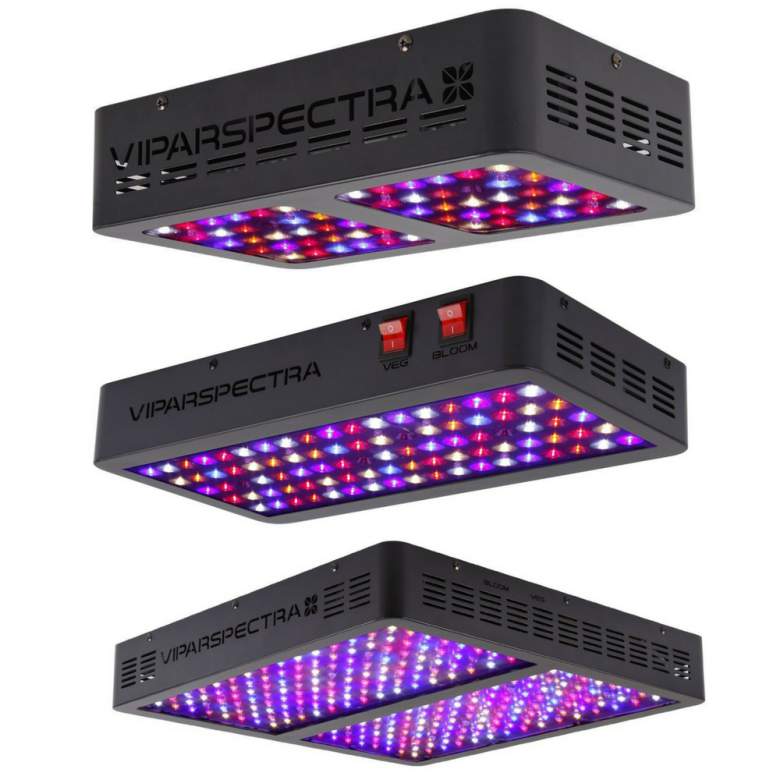 Knowing the exact square footage of the space needed to be illuminated is the first step. Too much light is a waste, but too little will leave plants deprived of light. This can cause yields that are far less than optimal.
Knowing the exact square footage of the space needed to be illuminated is the first step. Too much light is a waste, but too little will leave plants deprived of light. This can cause yields that are far less than optimal.
Most home growers are operating around fifteen to twenty-five square feet, but other grows can be significantly larger or smaller. LED grow lights specify a recommended coverage area, and are usually applicable to most indoor growers.
For larger industrial needs, take the time to make a blueprint of the grow space and create a light plan. You may find that you need fewer lights due to the compounding light of multiple fixtures.
Full Spectrum or Dedicated Phase
Many of today’s LED fixtures have full spectrum or full-cycle capabilities. That means that they can grow plants from start to finish in one place. Full spectrum LED lights allow you to grow your crop all in one spot. With them, you won’t have to change lighting systems or move the plants into another room.
Growers who have separate spaces for their plants to veg and bloom will have different lights respectively. During the veg phase a plant needs a strong blue spectrum. While plants are flowering, they require a heavier red spectrum.
Consider that one spectrum can provide for a plant’s entire life cycle. Even though it’s not ideal, dedicating a grow light of a specific spectrum is optimal to achieve larger yields.
Understanding the Full Spectrum
Plants naturally grow under the sun, which provides the full light spectrum of everything from UV to Infrared and beyond. As the sun moves throughout the day and seasons, the light spectrum that a plant outside would naturally receive changes.
When we grow plants indoors, our lights need to replicate the specific light spectrums that trigger a plant to photosynthesize. This results in a switch to its growth phase from veg to flower, etc.
White Light and Additional Wavelengths
Most of today’s top manufacturers of LED grow lights for indoor plants incorporate full spectrum white light into their fixtures. They do it using chip-on-board LED’s or single diodes. Others focus on red or blue spectrum lights.
The full spectrum of white light includes varying wavelengths including green light. Green light is important because it is able to penetrate into a dense canopy and drive photosynthesis where red and blue lights will not.
A lack of green light can lead to deficiencies in plants. Certain nutrients need more light blue and green wavelengths to activate their synthesis, such as Carotenoids. As long as a light is strong enough in red and blue wavelengths, it will still grow plants well. However, to produce the biggest yields, consider providing optimal full spectrum lighting conditions for the plants.
UV-A/B and Far Red
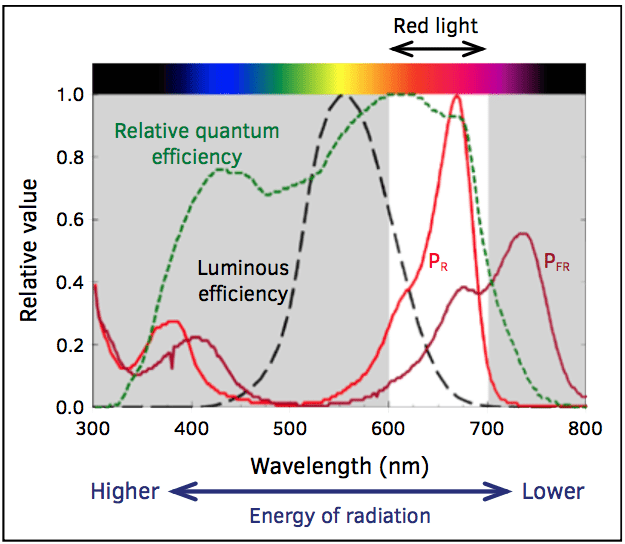 Many full spectrum LED light fixtures have supplemental lights to help provide a more balanced light to the plants. While UV-A is not necessary for good growth, most growers would suggest that it affects development. Also, metabolism producing heartier stalks and flowers.
Many full spectrum LED light fixtures have supplemental lights to help provide a more balanced light to the plants. While UV-A is not necessary for good growth, most growers would suggest that it affects development. Also, metabolism producing heartier stalks and flowers.
UV-B has been shown to improve trichome production, which increases THC/CBD and terpene content in the flowers. These are the chemical compounds with medicinal and psychoactive effects produced by cannabis.
Most full spectrum LED lights will also include infrared light. Simultaneously exposing flowering plants to the deep red spectrum and the far-red spectrum creates “The Emerson Effect”.
Essentially, plants experiencing this effect photosynthesize at rates substantially higher than what would be expected due to the compound exposure of the two spectrums of red light.
Wattage Draw
LED lights are supposed to be efficient. Look for lights with the lowest amount of wattage draw and with the largest coverage and efficiency. For example, two different lights that are both advertised to cover a 4’x4’ but one consumes twice as much energy. The same coverage is achieved, but one of the lights consumes costs a lot more to run.
However, just because a light is advertised to cover a certain space, doesn’t indicate its true intensity. Which, along with its wattage draw, determines a light’s efficiency. This is why understanding a light’s PPFD is important when shopping for the best LED grow light.
Light Output PPFD
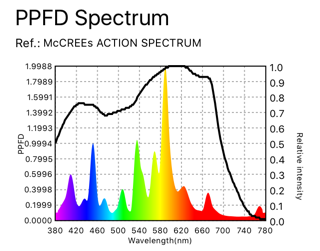 Photosynthetic active radiation, or PAR light, refers to the wavelengths of the light spectrum that drive photosynthesis. Manufacturers measure a light’s PPFD (Photosynthetic Photon Flux Density) by using a specialized instrument called an integrating sphere. Photosynthetic Photon Flux measurements are taken in the given area of coverage for the light.
Photosynthetic active radiation, or PAR light, refers to the wavelengths of the light spectrum that drive photosynthesis. Manufacturers measure a light’s PPFD (Photosynthetic Photon Flux Density) by using a specialized instrument called an integrating sphere. Photosynthetic Photon Flux measurements are taken in the given area of coverage for the light.
These measurements are mapped out around the given area of coverage, averaged, and expressed in micromoles per second (µmol./s). Higher density PPF from a light means it has a higher intensity light output. Such is ideal for growing tall, thick flowering canopies, or even short, dense ones.
Larger yields can be achieved by increasing PPFD, but some growers suggest that optimal PPFD is below 1000 µmol./m2/s. This is due to the investment return when considering excess light and energy draw.
PAR Efficiency
Par efficiency refers to how efficient a lighting system is at converting electrical energy into PAR light. Or, Photosynthetic Active Radiation; the wavelengths that a plant actually uses.
The par efficiency of a lighting system is expressed in µmol./J, or micromoles per Joule. Higher PAR efficiency means more light output with less energy consumption. The more efficient a lighting system is, the less it will cost to keep it running.
Par efficiency should be above 1.5 µmol./j. LED lights with par efficiency over 2.0 µmol./j are considered highly efficient.
Coverage Area
The sizes of grow space vary widely, so it’s important to know the exact dimensions of your available grow space when choosing a lighting fixture. You will want to choose one that can entirely cover your area.
The majority of growers go with the areas that measure 2’ x 2’, 3’ x 3’, 4’ x 4’, or 5’ x 5’. There are also sets of dimensions like 2’ x 4’, 3’ x 6’, 4’ x 8’, 8’ x 8’, etc. On the other hand, commercial growers have vast areas that may measure from 100 square feet to several thousand sq ft.
How To Choose the Right Grow Light For the Area You Need to Cover
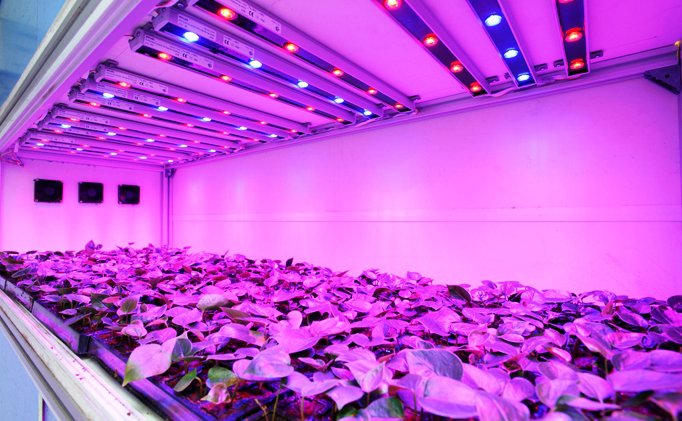 When it comes to LED grow lights for weed, they can cover 3’ x 3’ and 4’ x 4’ spaces in most cases. The biggest and the most powerful fixtures can even cover a 5’ x 5’ area.
When it comes to LED grow lights for weed, they can cover 3’ x 3’ and 4’ x 4’ spaces in most cases. The biggest and the most powerful fixtures can even cover a 5’ x 5’ area.
For footprints larger than this, you will have a hard time finding a grow light that provides fitting coverage. That’s because the corners and edges of the lighting footprint tend to diminish in intensity.
So if you plan on covering a larger area, you are advised to use a few smaller LEDs to get the uniform intensity of light over your canopy.
Let’s say you’re growing in an 8’x8’ area. You should use 4 lights, each of which each covers a 4’x4’ area, rather than buying the huge, extremely powerful grow.
If you have a smaller area measuring 2’x4′ for example, you can either buy two lights covering a 2’x2′ area or use one more powerful light that covers that particular area. Avoid using a light that is meant to cover, say a 3’x3′ area because this won’t provide the even footprint.
Some LED grow lights come with built-in lenses that allow you to focus your lighting onto the plants. These lights are usually placed a bit higher above the plants (at around 18″).
Other fixtures don’t use any lenses. In this case, the light is more diffused and spread out, while the footprint edges are less defined and softer.
Budget
This is the most limiting factor when shopping for indoor LED grow lights. Inexpensive lights are usually made with inferior parts that will break quickly, or are inefficient. A bigger budget can buy a larger, high end LED grow light. However, not all expensive LED grow lights can get the job done.
A good rule of thumb is to buy the best LED grow light that you can afford. High-efficiency diodes, high average PAR, uniformity, and a good warranty are all important factors to note.
Secondary Lenses, Advanced Features, Warranty
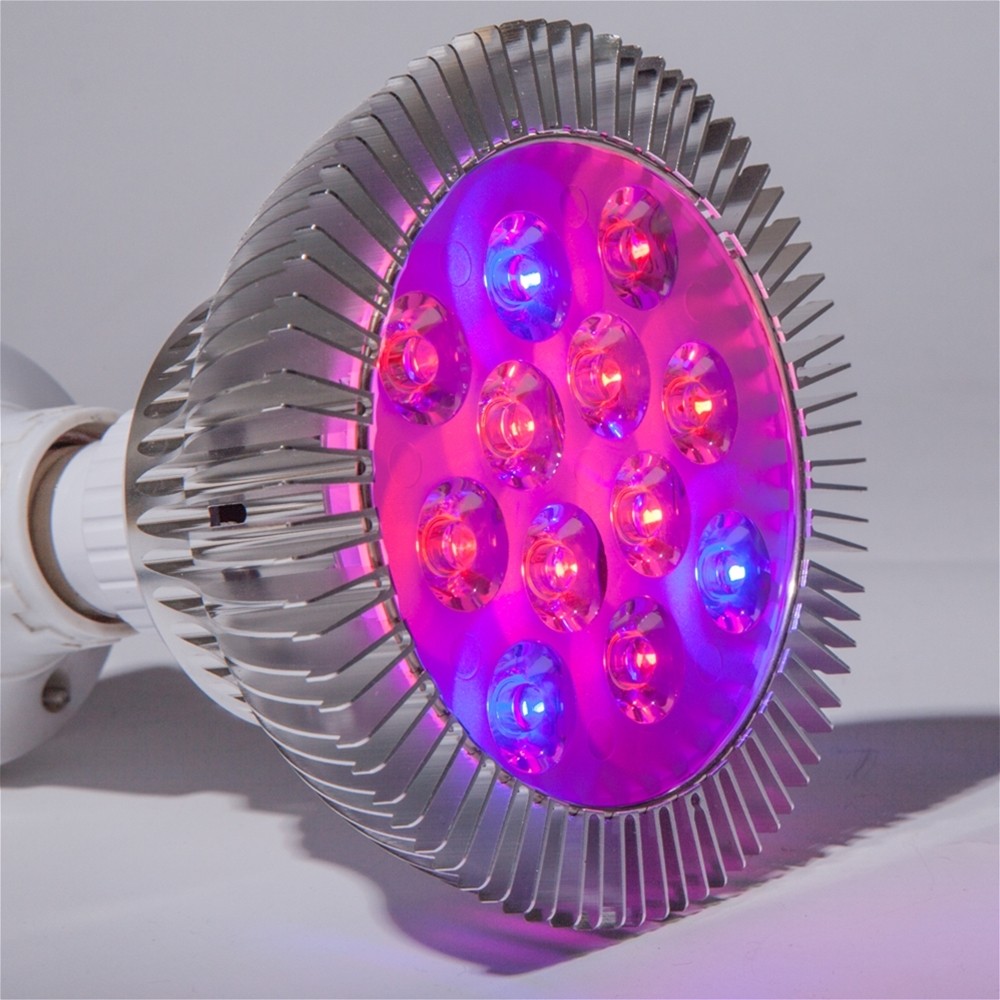 Secondary lenses, or secondary optics, increase light density (PPFD) by concentrating a light’s output into a smaller area. This can be achieved with reflectors, specialized lenses, or additional equipment.
Secondary lenses, or secondary optics, increase light density (PPFD) by concentrating a light’s output into a smaller area. This can be achieved with reflectors, specialized lenses, or additional equipment.
An LED grow light’s reflectors, secondary optics, features, and degree of angle of the LED’s themselves are also important factors.
Some high-end lighting systems come with advanced features like dimming ability, spectrum control, timers, and scheduling control. This is great for growers who seek complete lighting automation, or want to experiment with spectrums.
Buying a quality LED grow light can be a big decision and investment. A lifespan warranty is a manufacturer’s guarantee that their product will work for a certain amount of time. A 3-year warranty is standard, but 5 years is ideal. Some brands even offer a 7-year warranty.
LED Grow Lights FAQ’s
What are the benefits of LED grow lights?
- Energy efficiency – From 30% to 50% more efficient than traditional grow lights;
- Reduced HVAC costs and lower heating load;
- Increased growth, resin production, and density;
Long bulb life – they can last from 50,000 to 100,000 hours, which translates into is 5-10 years of continuous use; - Spectrum, timing, and dimming control with some fixtures;
- No reflectors or ballasts, meaning there’s no need for additional cooling systems or bulbs to replace;
- Low profile – perfect for multi-tier racking systems;
- Safe to operate, no mercury;
- Simple Plug’N’Play setup;
How far should LED grow lights be from plants?
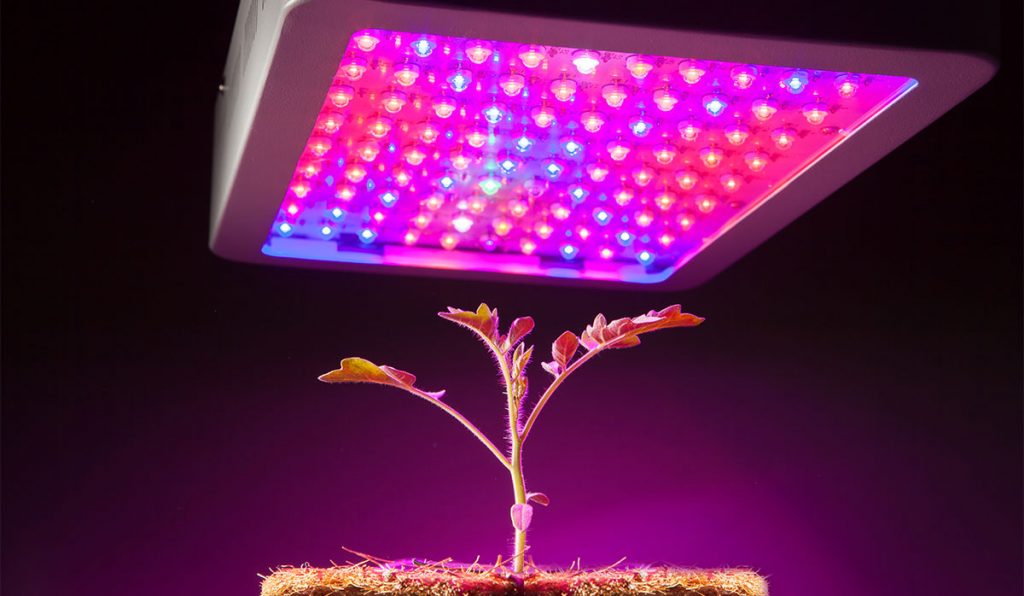 The optimal distances vary widely based upon different factors, such as coverage area, the brand, beam angle, light shape, and so on. These factors have an influence on PAR that comes in contact with the plant’s leaves.
The optimal distances vary widely based upon different factors, such as coverage area, the brand, beam angle, light shape, and so on. These factors have an influence on PAR that comes in contact with the plant’s leaves.
Your best bet would be to stick to the manufacturer’s suggestions for the certain light model since they are all a bit different.
Generally speaking, the most recommended distances are anywhere from 18″ to 36″. The 18″ is ideal for flower, whereas 24″ and greater distances are more suitable for veg.
How many LED watts will you need per sq ft of your grow space?
You’ll want about 32 of actual LED wattage (watts / sq ft). This is especially true for flowering. While some LEDs require less than this, others may require more. It mostly depends on efficiency.
As always, you should follow the manufacturer’s instructions, as every LED fixture has a different construction.
By the way, you don’t need to use wattage in order to figure out how powerful a light should be for your area. Instead, you should consider other more important factors like footprint uniformity and PPFD.
Can I use HID lights for veg and switch to LEDs for flower later on?
We do not recommend this. Once your plants become accustomed to particular light spectrum and intensity, the sudden switch of lighting source can ‘shock’ them and cause a delay in flowering.
It’s like growing plants indoors for some time and placing them outside all of a sudden without increasing exposure to the sun gradually. That can wreak havoc on the plants!
Does my LED grow light produce UV radiation?
Many studies have found that standard LED’s emit small amounts of UV radiation. That amount is even lesser when it comes to LED grow lights, meaning they are completely safe to use. This is another reason why more and more people grow with LED lights.
Does LED grow light give off heat?
Just like any other light, LED’s put off a certain amount of heat. Whether the light is coming from a diode or bulb, every type of grow light produces some heat.
LED’s have been proven to convert energy to light more efficiently than any other lighting system, while producing less heat at the same time. Some heat will be generated though. However, keep in mind that it’s much less compared to halogen or incandescent light bulbs.
What’s the best light color to grow marijuana plants in?
Red LED grow lights turned out to be favorable to plants during the flowering stage. Actually, red light can trigger a considerable response in plants during the blooming period. In a similar way, the blue light is the most absorbed by chlorophyll, which makes plants look green.
If you want to use a white LED grow light, note that it doesn’t actually refer to a spectral color. Such a fixture consists of a few different light colors, like red, blue, and green light (even though it appears white to the human eye). Besides, white light can’t be produced directly from the LED diodes; an individual LED light is capable of producing only one color.
Most grow lights you can find on the market these days are actually blue LED grow lights coated with phosphor. The blue light is converted into various colors.
The Bottom Line
The best LED grow light will depend on:
- Coverage area – What is the exact square footage available for growing?
- Spectrum – Are you vegging, flowering, or both?
- Wattage – Larger lights generally use more power and create more light. However, determine the right light for you based on light intensity, relative to the square footage of the grow space. PPFD and PAR evenness are ideal measurements to determine your grow lighting needs, not true wattage or HID equivalence.
- PPFD – How intense is the light output? Is the light output uniform or are their hotspots and weak spots in its coverage area?
- PAR efficiency – Is this LED light really super efficient, or is it claiming to be?
Our all-inclusive LED grow lights review will help you make a well-informed decision. When purchasing an LED grow light, it’s important to do research and understand the technical aspects of the product.
In certain grows, it may be best to use a particular light in conjunction with a grow tent. Such a tent should help to achieve an optimal environment for the plants. Some growers will find it best to combine two, or more, moderately powerful lights together. As opposed to getting one really intense light.
The best LED grow lights for indoor plants you can buy will have the correct intensity and coverage needed for your grow. It should also maintain high efficiency, low energy consumption, and low heat levels.

The team at LEDGrowLightsHQ.com is composed of expert cannabis writers and enthusiasts, many who frequent small grow operations for recreational purposes. We often provide insight from our partners or large publications or magazines.
